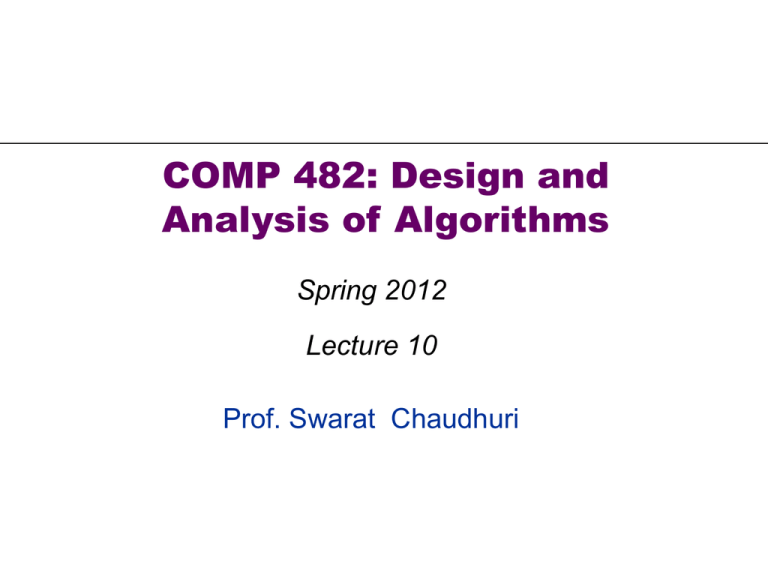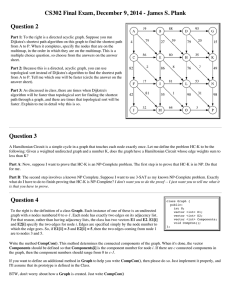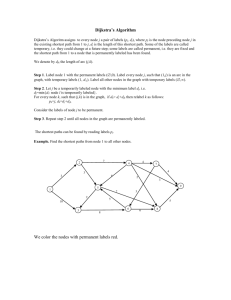Powerpoint slides
advertisement

COMP 482: Design and
Analysis of Algorithms
Spring 2012
Lecture 10
Prof. Swarat Chaudhuri
Q1: Topological ordering
Give an extension of the topological sort algorithm that we studied in
class that does the following. The input of the algorithm is an
arbitrary directed graph G that may or may not be a DAG. The
output is one of two things: (a) a topological ordering, thus
establishing that G is a DAG; or (b) a cycle in the graph, establishing
that G is not a DAG. The runtime of the algorithm should be O(m +
n).
2
Answer
Use the topological sort algorithm. If you find that every node has an
incoming edge, report a cycle. How to find this cycle? Just follow
the incoming edges backwards. At some point you will have to revisit
a node, as there are only n nodes. At this point you have your cycle.
3
Q2: Dijkstra with negative edge costs
Give an example of a directed graph with negative edge costs where
the algorithm produces an incorrect output.
4
Q3: Number of weighted shortest paths
Given a weighted directed graph (positive edge weights), find the
number of shortest paths from node u to node v.
5
Answer: Modify Dijkstra’s algorithm
MODIFIED-DIJKSTRA (G = (V; E); s in V )
Set d[v] = ∞ and count[v] = 0 for every node v in (V – {s})
Set d[s] = 0 and count[s] = 1
S = Ø, Q = V
while Q ≠ Ø
Let u be a node in Q such that d[u] ≤ d[v] for all nodes v in Q
Q = Q – {u}; add u to S
for each node v adjacent to u
if d[v] > d[u] + w(u, v)
d[v] = d[u] + w(u, v)
count[v] = count[u]
else if d[v] = d[u] + w(u, v)
count[v] = count[v] + count[u]
return count[v] for every node v in V
7
Q5: Graphs with specified degrees
Given a list of natural numbers d1,…, dn, show how to decide in
polynomial time if there exists an undirected graph G = (V, E) where
the node degrees are precisely the numbers d1,…,dn.
8
Answer
If any of the degrees is 0, this should be an isolated node in the graph;
so we can just delete that degree from the list.
Let us now sort the list so that d1 ≥ … ≥ dn > 0. Let dn = k.
Now consider the list L = {d1 – 1, …, dk – 1, dk + 1, …, dn – 1}.
Claim: the graph we want exists iff there is a graph whose degrees are
the items of L.
Note that L has one less element than the original list. So we can
proceed recursively to check if G satisfies the desired property.
9
Proof of Claim from previous slide
We prove the two directions of the “if and only if” separately.
() If a graph G whose degrees are the elements of L exist, then we
can add a node vn and connect it to the first dn nodes of G in the
descending order of degrees.
() Suppose there’s no graph whose degrees are the elements of L, but
at the same time, there’s a graph G of the sort demanded by the
problem. Let vi be the node with degree di in G. By assumption, we
have i and j, with j < i, such that G has an edge of the form (vn, vi)
but no edge of the form (vn, vj).
But because of the way the list is sorted, we have dj ≥ di. This means
there is some v such that G has an edge (vj, v) but no edge (vi, v).
Now let us apply an exchange argument. Let us replace G by a graph
G’ which is exactly like G, but where: (1) there is no edge (vn, vi) or
(vj, v), and (2) there are edges (vi, v) and (vn, vj). Applied repeatedly,
this transformation gives us a graph whose degrees belong to L,
giving a contradiction.
10











